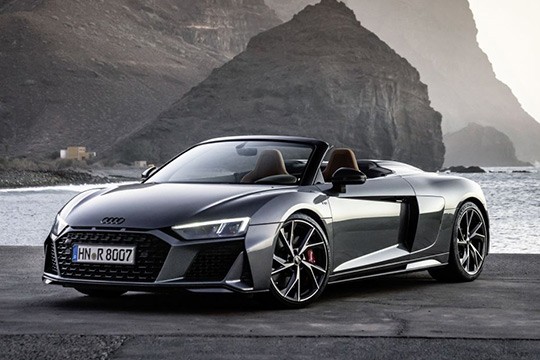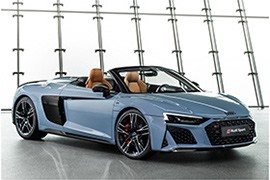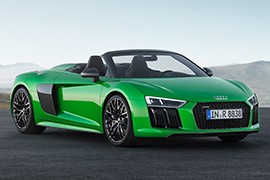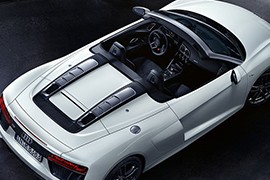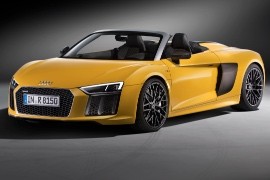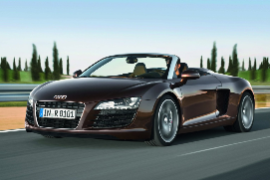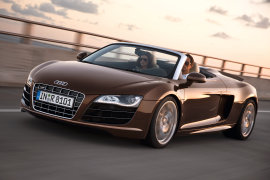AUDI R8 Spyder Models/Series Timeline, Specifications & Photos
First production year: 2010
Engines: Gasoline,
Body style: Convertible (spider/spyder, cabrio/cabriolet, drop/open/soft top)
Audi refreshed the second generation of the R8 V10 in 2018, but it was not done making surprising moves, and in the summer of 2021, it released the Performance RWD versions of it in both coupe and open-top shapes.
Along with the coupe version of the R8 V10 Performance, Audi also introduced an open-top version of it, traditionally named Spyder. This was created for those who wanted to feel more air around them when they were driving fast on a race track or on a twisty road. As expected, the rag-top version of this performance-oriented supercar was heavier than its coupe sibling. But still, thanks to the advanced engineering and the massive use of CFRP (Carbon Fiber Reinforced Polymers) panels, it weighed just 105 kg (231 lbs.) more than the coupe, but it was lighter than the regular, all-wheel drive version R8 V10 Spyder by 55 kg (121 lbs.). Part of the weight reduction was the lack of a front differential and driveshafts, which also affected weight distribution.
From its front, the R8 V10 Performance Spyder shared most of its elements with the coupe. It featured a wide grille with a honeycomb pattern mesh on it that was flanked on its upper sides by the LED headlights. On the lower part of the bumper, Audi placed a set of side air intakes that cooled the front brakes and two vertical slits that created air curtains to lower the drag coefficient. Another specific detail of the R8 Performance RWD was the three slits at the lower part of the hood, a reminiscent detail carried over from the Ur-Quattro from the early '80s.
From its profile, the car had a similar shape to the regular V10 Spyder. Still, a few particular details differentiated it from its sibling. Audi adorned the front fenders with black V10 badges instead of chromed ones, like on the all-wheel drive model. Then, the car ran on 19-inch wheels at the front and 20-inch in the back. Finally, out back, the car sported a broad trim featuring a hexagonal mesh pattern that stretched from side to side, resembling the Ur-Quattro rally car. In addition, a set of rounded exhausts peaked under the bumper, flanking the massive diffuser.
As expected, the cabin was good for two, offering customers a pair of sports seats with high bolstered areas to keep them in place during high-speed cornering. Audi used Nappa leather for the upholstery since that material could withstand rain better. Fronting the driver was a flat-bottom steering wheel that housed four round switches next to the lower spoke. Audi placed there the start/stop button, the drive-mode selector, the controller for the Virtual Cockpit display, and the one that activated the performance mode. The driver could cover or uncover the three-layer canvas top in about 20 seconds at a speed of up to 50 kph (31 mph).
But the most important part of the vehicle was its drivetrain. The 5.2-liter V10 engine produced 570 PS (562 hp) and sent to the rear wheels via a seven-speed automatic (dual-clutch) gearbox. In addition, the car's adaptive suspension and electromechanical steering helped drivers get faster laps around a race track and also obtained controlled drifts. Last but not least, it was fitted as standard with ceramic disc brakes.
AUDI R8 V10 performance RWD Spyder 5.2L V10 Perfromance RWD 7AT (570 HP)
Audi introduced the second generation of the R8 V10 in 2015 as a coupe only, followed by the open-top version in the following year, but in 2018, the German automaker refreshed the entire lineup.
After more than 30,000 units sold since 2006, in two generations, the R8 became a respected supercar. Even if the first generation came in a bad moment, facing the world financial crisis, the car remained on the market. Audi could afford that and pushed hard its engineering department to make a better vehicle for the car's second generation that appeared in 2015. Then, in 2016, it chopped the car's roof and offered it as a roadster, or Spyder as the automaker named that version. Fast forward to October 2018, and Audi introduced the facelifted version for the entire lineup, including the Spyder.
Audi started by changing the car's front fascia. For the 2018 model year, it featured a broad grille covered with a honeycomb mesh instead of the slatted one as on its predecessor. The same hexagonal pattern was used to fill the side scoops and the newly introduced air curtains that diverted the airflow around the bodywork for better aerodynamics.
From its profile, the open-top version of the 2018 R8 V10 featured black V10 badges on the front fenders instead of chromed ones like on its predecessor. A new set of 19-inch alloy wheels was also included for the refreshed version of the vehicle, while a set of 20-inch ones was on the options list. Depending on customers' options, the side intakes could be black or finished in a carbon fiber look. These were made from CFRP materials, anyway. But the most significant change was noticed at the back. There, Audi installed a broad grille with a honeycomb pattern extended from side to side. It resembled the one installed on the mighty Audi UR-Quattro from the early '80s that dominated the World Rally Championship. Below, under the bumper and flanking the rear diffuser, the automaker installed two big round exhausts.
Inside, most buttons and parts were similar to other Audi models. The three-spoke steering wheel was unique for the R8 V10. It featured several buttons, including the start-stop one, the drive mode dial, and the infotainment system's switches. Since there was not enough room in the cabin, the automaker combined the screen for the infotainment unit with the instrument panel, named the Audi Virtual Cockpit. The leather-wrapped sports seats provided enough side bolstering to keep their occupants in place during high-speed cornering. Audi installed the triple-layer canvas top behind the cabin, concealed under a tilting CFRP cover. Drivers could raise or lower the roof above them in just 20 seconds at speeds of up to 50 kph (31 mph).
Audi installed the engine behind the cabin, like any other proper supercar. The facelifted version was available in a choice of powers delivered by the same 5.2-liter V10 shared with the Lamborghini Gallardo. All versions were paired with a seven-speed automatic (dual-clutch) S-Tronic gearbox.
In 2016, at the New York Auto Show, Audi unveiled the second generation of the R8 V10 Spyder and its more powerful brother, the R8 V10 Spyder Plus.
After the successful introduction of the R8’s second generation at the 2015 Geneva Motor Show, the German automaker prepared the drop-top version of it, namely the R8 V10 Spyder. When the customers saw the Spyder version of the 2016 R8, they were also surprised to find out that the German roadster was available with the Plus setup as well. Unlike its regular sibling, this pumped-up version came with a lighter bodywork thanks to carbon fiber panels, a sports-oriented cockpit, and an improved drivetrain.
From the outside, the R8 V10’s Spyder Plus boasted a set of LED headlights with an angular design. They featured upside-down L-shaped daytime running lights mounted on their outer sides, above the main LED beams. The massive singleframe grille, Audi’s design signature element, sported a honeycomb mesh to differentiate this potent version from its lesser-powered sibling. In addition, the automaker used the same pattern to cover the side scoops mounted on the lower side of the bumper. These were not decorations, they cooled the front rotors.
The Spyder’s profile unveiled the thick and black A-pillars that supported the windshield. Audi used the same color for the door mirror caps and the flaps that covered the side intakes mounted behind the doors. Behind the cabin, the automaker installed a lid that covered the storage area for the retractable canvas roof. Audi used a three-layer, lightweight canopy. It didn’t want to use rigid materials to keep the car’s weight low. Finally, at the back, the 2016 R8 V10 Spyder Plus differed from its non-Plus sibling. It featured a fixed carbon fiber lip spoiler on the rear side of the deck. Furthermore, the vents placed underneath the angular-shaped LED taillights sported the same honeycomb mesh pattern as the front grille. Lower, on the apron, the automaker installed quad pipes with a squared design, unlike the regular R8, which had two rectangular ones.
Customers found a pair of lightweight sports seats wrapped in Nappa leather painted with a special pigment that didn’t let them heat too much under the sun. In front of the driver, Audi installed the 12.3-inch display for the Virtual Cockpit. The tachometer took center stage and surrounded the digit-shown speedometer. A flat-bottom steering wheel that sported more buttons than the center console helped the ones behind the wheel control not just the infotainment and the onboard computer data shown in the instrument cluster, but also adjust the driving modes. On the center stack, Audi installed the dials for the HVAC system, while the center console housed additional commands and controls for the infotainment unit and the gear selector. The car manufacturer adorned the cabin with several carbon fiber trims.
But the most significant upgrade for the vehicle was found under its skin. The dry-sump lubrication system ensured that the car couldn’t run out of oil, regardless of circumstances. Its adaptive suspension and the standard carbon-ceramic brakes could give customers the peace of mind they needed on a fast drive. The 5.2-liter V10 placed behind the cabin produced 610 PS (602 hp) and was paired to a seven-speed automatic (dual-clutch) gearbox. Power went in all corners.
If the R8 V10 RWS was not enough for those looking for a thrilling experience in a German supercar, then Audi offered them an open-top version of that rear-wheel-driven supercar to satisfy their taste.
The R8 V10 was already a hit on the supercar market, and other car manufacturers had to admit that Audi found an excellent recipe for that. It was a vehicle that could be driven daily since it was comfortable enough but also thrashed around corners on a track. It could cope well with that treatment, too. But then, customers started to ask for something more rough, more brutal. Audi answered with the pumped-up version named R8 V10 Plus. But that was not exactly what purists wanted. They craved for a rear-wheel drive supercar. Then, Audi introduced the limited-edition RWS versions: the coupe and the Spyder.
To prove that this was a car made for purists, Audi made subtle changes to it compared to the rest of the R8 V10 Spyders it had already produced. The front side featured the same broad grille covered with a honeycomb mesh like the R8 V10 Plus on this version, but it was finished in matte black instead of piano black. Moreover, instead of a quattro badge, it sported the Audi Sport one on the left upper side. The same mesh pattern as on the main grille was used to fill the side scoops that cooled the front vents.
From its profile, the car featured the same thick A-pillars as the rest of its Spyder brothers but sported a satin silver finish instead of black. Furthermore, the door mirror caps and the side intakes mounted behind the rear doors were body-colored. The R8 V10 RWS was fitted with standard black 19-inch alloy wheels with a unique design for this version. At the back, Audi made another interesting design change. The R8 V10 RWS Spyder featured twin exhausts on each side, finished in black and flanking the massive diffuser placed under the bumper. The rear fascia resembled the one from the R8 V10 Plus, not the one from the R8 V10 RWS.
Audi installed the same sports seats inside the cabin as those in the R8 V10 RWS Coupe, with Alcantara interior and Nappa leather exterior. The driver fronted a flat-bottom steering wheel where the start-stop button was placed on the right side of the lower spoke while the drive mode selector mirrored it on the left side. The instrument cluster was filled by a 12.3-inch TFT screen that showed the tachometer in the middle, around the digit-style speedometer. It also displayed data for the infotainment system. On the dashboard, an aluminum plate had shown the vehicle's production number, such as "1 of 999." Because just 999 units were produced.
Behind the cabin, Audi installed the same 5.2-liter naturally aspirated engine that powered the rest of the R8 V10 range. It paired it with a seven-speed automatic (dual-clutch) transmission that sent the power to the rear wheels only.
Audi introduced the second generation of the R8 at the 2015 Geneva Motor Show and saved the drop-top version for the American continent, unveiling it at the New York Auto Show in 2016.
Supercars were no longer just toys for the track, and car manufacturers were aware of that. That’s why Audi developed the R8 V10 Spyder in parallel with the coupe version. As a result, the open-top variant of the four-ring badged supercar was ready to meet its clients soon after its fixed-roof sibling was on the market. Audi had to wait almost three years for the previous generation to reveal the rag-top version after launching the coupe. For the second generation of this nameplate, it didn’t repeat that mistake. Just like its sibling, the 2016 R8 Spyder was available exclusively with a V10 engine behind its cabin.
The new model was wider than its predecessor and sported an aggressive design. Its sharp lines and angular-shaped headlights flanked Audi’s signature design element, the singleframe grille. This was, too, penned with crisp lines and clear-looking angles. It was flanked by rectangular scoops that featured vertical slats to cool the front rotors. To emphasize the new generation, the car sported two creases on the hood that visually connected the headlights to the windshield.
From its profile, the Spyder version carried over the front fenders and the chromed V10 badges from its coupe sibling. The A-pillars that supported the windshield, on the other hand, were thicker since they served as rollover protection and sported a contrasting color. While the sculptured doors, with their hidden handles concealed under the upper creases that crossed the car to channel air into the side intakes, were similar to those from the coupe, the rear deck differed. It featured a large cover for the retractable canvas top and was adorned by longitudinal vents.
The cabin boasted a set of sports seats with leather upholstery separated by a narrow center console where Audi installed the gear selector, the infotainment system’s controller, and an armrest with tiny storage underneath it. Fronting the driver was a new instrument cluster that housed a digital display instead of analog dials. Audi named it Virtual Cockpit and sported the tachometer in the middle, around the digit-shown speedometer. Drivers could opt for what other information should appear on the sides of the rev counter via the buttons on the flat-bottom steering wheel. Customers could cover or uncover the vehicle in 20 seconds via a button on the center console at speeds of up to 50 kph (31 mph).
The second generation of the R8 came exclusively fitted with a V10 engine. Audi sent the 4.2-liter V8 powerplant used on the previous generation to retirement. It also improved the new 5.2-liter FSI engine to produce 540 PS (532 hp). Audi paired it with a seven-speed automatic (dual-clutch) gearbox that sent all the oomph to all wheels.
Four years after the commercial launch of the R8 Coupe with a V8 engine, Audi unveiled the open-top version of it named the R8 Spyder, made for those who wanted to enjoy the "wind-in-the-hair" sensation while driving the German supercar.
Unlike Porsche cars, which had engines behind the rear axle, the R8 was a mid-ship construction and considered a legit supercar. Even though the performance of the V8-powered R8 was not as good as some Italian supercars, it was almost there, especially regarding the drivetrain layout. But Audi knew that many buyers didn't want the R8 for its face-melting accelerations but for the look, feel, and pleasure of driving a mid-engine supercar that could go faster than most other cars on the road when pushed hard. Audi introduced the Spyder version of the R8 to enhance the pleasure in 2011, managing to not add too much weight compared to the R8's coupe version. Surprisingly, though, the R8 V8 came after the V10-powered version introduced a year earlier. As expected, it was less expensive than its more potent brother.
While both R8 Spyders looked similar, there were a few significant differences between them. The R8 V8 featured Audi's signature singleframe grille at the front flanked by big air intakes that cooled the brakes. These were adorned by three horizontal slats instead of two, as on the R8 V10. The car came fitted with standard Xenon headlamps, while the LED ones were optional. Regardless of the version, both came with integrated daytime running lights integrated into their lower and outer sides.
From its profile, the R8 V8 boasted its standard 18-inch alloy wheels, while a 19-inch set was available. The silver A-pillars that supported the windshield were thick and served as protection in the event of a rollover crash. Audi installed CFRP (Carbon Fiber Reinforced Plastic) to lower the car's weight for the side panels that channeled air into the engine compartment behind the cabin. The same material was used to make the retractable roof compartment cover. Finally, at the back, the automaker installed a pair of four-slat vents underneath the taillights, while the bumper sported the four exhaust system with two round pipes on each side.
The R8 V8 Spyder boasted a luxurious cabin with leather-wrapped high-bolstered seats for the two occupants. These were divided by a narrow center console where Audi installed a pair of cupholders, an armrest with a storage compartment underneath, the handbrake, and the buttons to cover or uncover the car. At the touch of a button, occupants could raise or lower the rag-top from behind the cabin in 19 seconds at speeds of up to 50 kph (31 mph). Fronting the driver was the same binocular-styled instrument cluster that featured a large speedometer, a tachometer, two gauges for the fuel level and coolant, plus a TFT display in the middle for the onboard computer.
From the technical point of view, the R8 V8 Spyder didn't disappoint its owners with its 43:57 weight distribution. The engine sent 430 PS (424 hp) in all corners via a six-speed manual gearbox with a two-clutch disc system or a six-speed automated (single-clutch) transmission.
Audi was happy with its R8’s success on the market, especially after it launched the V10 version, so it considered chopping the roof of its supercar to be a good idea.
Audi gained a seat at the supercar-makers’ table with the coupe version, but that was not enough for the German automaker. So, after the world financial crisis showed clear signs of slowing down and the automotive segment started to bounce back, it launched the R8 Spyder as a contender against other high-powered, expensive vehicles. After all, the car shared its underpinnings with the Lamborghini Gallardo, which was also offered as an open-top vehicle. But since Cabriolet sounded too mundane, Audi used the Spyder name instead. A nameplate that was considered specific for high-speed vehicles, and the R8 perfectly matched the description.
At the front, the automaker placed the specific signature element named the singleframe grille. It surrounded it with a chromed trim and adorned it with an egg-crate style mesh. The entire assembly was flanked by the LED headlights that sported pearl-like daytime running lights on their lower and outer sides. Underneath them, Audi installed the air intakes that cooled the front rotors and decorated them with two slats, specific for the V10-powered version of the R8.
From its profile, the roof-less R8 featured thick A-pillars that also served as protection during a rollover crash. It also created a new storage area behind the cabin for the retractable rag-top and covered it with an aerodynamically profiled lid that featured two small bumps. Unlike the coupe, which featured contrasting-colors side intakes, the R8 Spyder featured body-colored ones. The overall waved shapes of the vehicle were extended towards the back and ended into an almost flat and tilted forward rear fascia. There, the automaker installed the taillights with visible rectangular light blocks inside them. Underneath the bumper, the car featured broad cooling vents with two horizontal and two vertical slats. Finally, on the lower side of the apron, flanking the diffuser, there were two oval exhausts.
Inside, the two-seat convertible provided sports seats with high-bolstered areas. Fronting the driver was a binocular-styled instrument cluster with large dials for the speedometer and tachometer and smaller ones for the coolant temperature and fuel level gauges. In addition, a red TFT display showed data from the car’s onboard computer. Audi installed a power-operated mechanism for the roof, and the driver could open or close the cabin in 19 seconds at speeds of up to 50 kph (31 mph).
Behind the cabin and the retractable roof compartment, Audi installed the 5.2-liter V10 engine. Thanks to its direct fuel injection system, it provided 525 PS (518 hp) that it sent in all corners via either a six-speed manual or a six-speed automatic.
